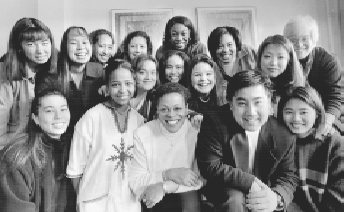Circle of Hope
SPU's Cadre for Students of Color Fosters Community, Communication and Education
by Connie McDougall
| ||
| The SOCASP cadre is led by Darlene DuBose (bottom center) and Rich Okamoto (to her right). While the cadre welcomes all people to its weekly discussions, the group has a special bond because of the common experience of being minorities within a majority culture. |
It's Thursday morning on the Seattle Pacific University campus, and dozens of students hurry to "cadres," small groups designated for Bible study or discipleship. In Marston Hall, the SOCASP (Students of Color at Seattle Pacific) cadre comes together in a rainbow of ethnicity: Asian-Americans, African-Americans, a Native American - and one rather conspicuous Caucasian.
The cadre leaders are Darlene DuBose, coordinator of ethnic student outreach, and Rich Okamoto, coordinator of academic support services, both of whom work out of Seattle Pacific's Office of Educational Services.
Today's subject is discrimination. One student recalls, grim-faced, the names from grade school: "Chink" or "Jap girl." Even now, a young woman on a Christian college campus, she often feels isolated and uncomfortable. "Sometimes I'm ashamed to be different," she tells DuBose. "But God made me this way. Why shouldn't I be myself?"
The SOCASP cadre, organized almost seven years ago by Okamoto and now fueled by the fierce devotion of DuBose, serves purposes as diverse as its membership. "I want this cadre to show students how to deal with prejudice, but also to reveal their own intolerance," explains DuBose. "My idea of cadre is community, communication and education." The work, she hopes, is ultimately "redemptive."
DuBose, the great-great- granddaughter of slaves, illustrates with a story. "When I was about 10, my mother sat me down and told me about prejudice. It was an ugly thing, she said, but I didn't have to accept it. I had a choice. She told me not to take on other people's problems. You leave it with them, she said, then go work on yourself."
That's precisely the attitude senior Mylanna Lee developed during her four years of attending the cadre faithfully every week. "I want to be an example to other students, to show them they can make it here too," she explains.
Another cadre regular this year is Frank Dominquez, a member of the Chumash tribe of California who calls himself "the minority of minorities on campus." As he works on a nursing degree to take back "to the rez," he's aware of being "an Indian on a white campus."
"In my custom, the tribe is a circle of people where everyone is connected. The cadre is like that. It's my circle away from my circle."
Also a member of SOCASP this year is Martha Worcester, an SPU associate professor of nursing and chair of CREA (Committee on Racial and Ethnic Affairs). As the only Caucasian to attend regularly, she admits to a strong motive. "I want to find out what's going on for these students on campus, because it can be hard for them."
It can be hard; that's why DuBose seeks out students who could use a little support. "On the first day students move in, I go up and down in the residence halls looking for minorities because I know many will be overwhelmingly lonely," she says.
Occasionally, she and Okamoto mediate roommate conflicts. When two people have never lived closely with another race, misunderstandings may arise. "It's a culture clash," says Okamoto. "They may have very different tastes in music or food, for instance. We want to help students because social problems keep them from learning."
Working through mistrust, ignorance and indifference is just a start, says Worcester. "We need more diversity on campus," she states. "In the real world, people must cross ethnic and cultural boundaries all the time. Students need to be comfortable with that."
Lee agrees, stating that confronting racial issues should not be the role of a single cadre. "This should be a community issue," she says.
Like most difficult situations, racial reconciliation takes time, says
DuBose, but she and Okamoto are up to the challenge. "I keep at it
because of the students," says DuBose. "When I get tired or discouraged,
I just say, 'You can use me, Lord. I'm ready.'"

Please read our disclaimer.
Send any questions, comments or correspondence about Response to
jgilnett@spu.edu
|
